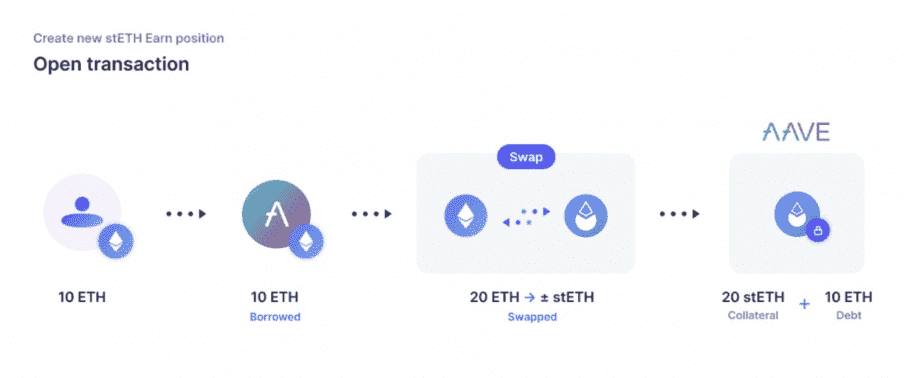The lending platform Aave and the DeFi app “Oasis” started a cooperation on October 24th new Ethereum staking product. Users should be able to earn more returns on their staked ETH with the product, resulting in a simplified DeFi strategy. But there are concerns about the security of the product – and the centralization of staking.
Recursive trading
“Aave Interest Bearing stETH” (ASTETH) its creators imaginatively named the Ethereum derivative. It combines steps of an existing strategy in one transaction. The strategy called “stETH/ETH Multiplier” is offered oasis, a branch of the Maker DAO protocol. The procedure is as follows:
Traders deposit ETH on Lido Finance and receive the well-known “staked ETH” derivative stETH. This can be lent on lending platforms such as Aave, and in return further ETH can be borrowed. Traders can in turn deposit this back into Lido – and so on. A recursive loop that generates more and more stETH. At the same time, more and more amounts of ETH are being lent on Aave.
Instead of working through the loop in individual steps, investors can now complete everything in one transaction on Oasis with ASTETH. The possible return is between 5 and 14 percent. Sounds easy at first, but as always, there are risks.
read too

depegging
For stETH and associated strategies, there is always a risk that the token will lose its (quasi) parity with ETH. Because unlike stablecoins, the exchange ratio of stETH to ETH is not fixed. If the price of stETH slips drastically below that of ETH, the derivative can no longer be exchanged 1:1 for ETH.
In June of this year, the “stETH depegging” was fatal for the lending provider Celsius, which invested heavily in the Ethereum derivative with customer funds. A similar fate would befall traders who have deposited stETH as collateral on Aave to borrow ETH. Upon the cancellation of their security, their position would be liquidated.
A chain reaction continues to threaten in the course of the recursive trading strategy. This is because they lend out large amounts of ETH, which could drive up lending rates and make ASTETH positions unprofitable. As a result, traders are likely to liquidate their positions and push the price of stETH further and further away from parity, amplifying the above effect. A cascade of liquidations would follow.
centralization
The risk of depegging has diminished since the Ethereum merge, as resolving the Ethereum staking rewards with the consensus mechanism changeover has become more tangible. At the latest when traders finally activate their staked ETH as part of the Shanghai update, a stETH rate deviating from parity would be even less likely.
Recently, however, Lido has been a particularly relevant player on the issue of Ethereum centralization. According to the analysis platform Messari, the platform is still the largest provider of Ethereum staking with a share of more than 30 percent. Lidos share among all liquids staking providers is loud Dune Analytics even at 68 percent.
The example of the new derivative on Oasis makes it clear that Lido’s stETH is being used more and more as collateral for a number of DeFi strategies. The founder of MakerDAO, Rune Christensen, explains in his blog post “end game” even how stETH could become the basic collateral of the protocol.
For a thriving and secure DeFi ecosystem, a little more competition among providers would certainly be healthier. Danny Ryan, researcher at the Ethereum Foundation, agrees. In his report”The Risks of LSDHe explains: “Liquid staking derivatives (LSD) like Lido are prone to cartelization and pose significant risks to Ethereum in terms of tied-up capital.”
Staking no longer seems to be about ensuring network security, but increasingly about promoting the DeFi ecosystem. But at what price?
Do you want to buy cryptocurrencies?
Trade the most popular cryptocurrencies like Bitcoin and Ethereum as an ETP on Scalable Capital, the leading investment platform in Europe.
